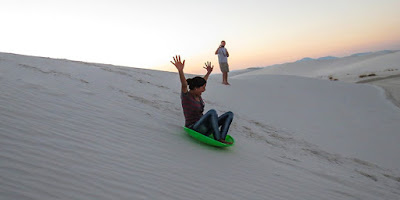 |
| White Sands National park's gypsum dunes are perfect for sledding. White Sands NPS photo. |
 |
| Map of sledding areas in White Sands National Park. Click for larger version. |
Sledding on the snow-like dunes is a favorite activity of the park’s visitors with most of them doing so in the Heart of the Sands area. There’s not a trail exactly, but you’ll do a lot of walking – all uphill – as you ascend the dunes and then slide down them.
Best of all, though, you can sled without stuffing yourself inside all of those bulky winter clothes.
To reach the sledding area, from U.S. Hwy. 70 enter the park on Dunes Drive. Once past the parking lot for the Interdune Boardwalk, vehicles are allowed to park off the side of the road.
While visitors often do this as soon as they see the first open dune to sled on, a much better choice is continuing to where the road loops, known as the Heart of the Sands area. This region will be less crowded, and there are actual parking lots. Any of the picnic areas are a good option. Being able to sled away from the main road also will be safer. The steepest dunes, however, are halfway along the loop as you begin heading toward the park entrance.
Unlike regular sand dunes, gypsum actually is great for tobogganing, as the firmer particles prevents the sled from sinking or piling up in front of you.
Unlike snow, which when compact turns to ice, the gypsum is not slippery. Because of this, sleds need to be waxed. Plastic saucers also tend to work best.
Selecting a dune to sled
You can bring your own sled or purchase one at the gift shop back at the entrance. Wax for your sled also is available there in case you forgot it. If you slide down in the same spot several times, that will create a smooth track, which reduces friction and so increases your speed.
The best kind of dune to slide is one with a gently sloping face and a level end. This allows you to come to a safe stop.
Take note of where the dune slope meets the desert floor. While the gypsum sand is soft, the base of the dune that is thin and touches the regular sand beneath can be extremely hard. Injuries have occurred.
Don’t come to a stop in a roadway or a parking lot either. That will be just as hard as the desert floor with the added threat of moving vehicles.
How to go fast
Also make sure there are no plants, sand clumps, or other obstructions in your sled’s path. Besides destroying the fragile vegetation, you’ll probably get scratched or cut up from sharp thorns, and those sand clumps can be like hitting concrete.
Sitting in the sled with your feet pointing downhill can make you more aerodynamic and increase your speed. Don’t sled head first, though; while that still is fast, gypsum particles can more easily blow into your eyes, and should you crash, your noggin likely will take the brunt of the blow. Don’t stand while sledding either, as you easily can lose your balance.
If little children are with you, they always should sled with an adult. Older children should be told about the various safety rules before allowed to hit the dunes.
Be sure to don sunscreen and sunglasses while sledding. The bright sun and reflection off the white sand will burn you quickly, and the all-white terrain will be blinding without eye protection.
